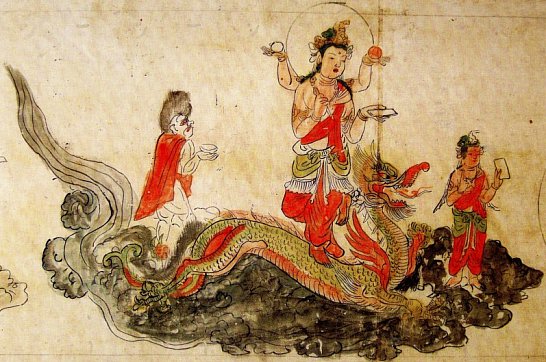Buddha Statues & Japan – October 2010
Hello Subscribers,
Knowledge updates for October 2010.
A-to-Z Photo Dictionary of Japanese Buddhism
» Myōken Bosatsu 妙見菩薩 – Deification of North Pole Star & Big Dipper.
www.onmarkproductions.com/html/28-moon-stations.html#myoken
Added 40+ photos and revised text. In Japan, worship of the northern Pole Star (Hokushin 北辰) along with the seven stars of the Big Dipper (Hokuto Shichisei 北斗七星) is a syncretic blend of Buddhism, Taoism, Onmyōdō 陰陽道 (Yin-Yang Divination), and local kami cults, but it is especially important within Esoteric Buddhism, and from the Heian period (794-1180) onward, Myōken was venerated under various guises as the central star controlling all other celestial bodies, one believed to control the life and fortunes of the people, one who protected not only the emperor and country, but also warded off diseases, prevented calamities of fire and other disasters, increased life spans, and healed eye diseases. As a deification of the Pole Star, Myōken was also worshipped as the deity of safe voyages and navigators. In Japan, even today, s/he is venerated at both Buddhist temples and Shintō shrines. The annual Myokensai (or Myōken Festival) is held on Nov. 22-23 each year. See Events below for details.

Four-armed Myoken atop dragon, holding sun & moon discs, and brush & tablet (on which s/he records our good/bad deeds). Surrounded by two attendants. Handscroll, color on paper. Kamakura Era (13th-14th century). Important Cultural Property ICP. Treasure of Shomyo-ji Temple, Kanagawa, but now housed by the Kanagawa Prefectural Kanazawa Bunko Museum . Image based on drawing in the Zuzosho, or the Encyclopedia of Buddhist Icons, a text edited by Eju (1060-1145 AD).
Current & Upcoming Events in Japan
» Myōkensai 妙見祭. The Myōken Festival at Yatsushiro Shrine 八代神社 (aka Myōkengū 妙見宮)in Yatsushiro City 八代市 (Kumamoto Prefecture 熊本県) is held annually for two days on Nov. 22-23. This lively festival involves a parade featuring a six-meter-long turtle with a two-meter-long snake head that is carried around town. This half-snake half-turtle is called a Kida 亀蛇. See numerous photos of the festival at this J-site www.yado.co.jp/kankou/kumamoto/kumanan/yatsushiro/yatsushiro2.htm.
» Shichi-go-san 七五三. Seven-five-three ceremony. In mid-November each year, children aged seven, five, and three don their finest traditional garb and visit their local shrines to be blessed. Special Shintō rites are performed to formally welcome girls (age 3) and boys (age 5) into the community. Girls (age 7) are welcomed into womanhood and allowed to wear the obi (decorative sash worn with kimono).
» Bunka no Hi 文化の日. Culture Day, November 3. National Holiday. Establish in 1948, but before that celebrated as the birthday of the Meiji emperor.
» Kinrō Kansha no Hi 勤労感謝の日. Labor Thanksgiving Day, November 23. National Holiday. Established in 1948, but before then it was celebrated as the Imperial Harvest Festival (Niinamesai 新嘗祭). A rice-tasting ceremony (one of Shintō’s main rituals) is performed each year when the emperor offers the newly harvested rice to the gods and then eats a little himself.
» Tokyo National Museum November Schedule. www.tnm.go.jp/en/servlet/Con?pageId=X00&processId=01
» Nara National Museum, The 62nd Annual Exhibition of Shōsō-in Treasures ends on November 11. www.narahaku.go.jp/english/exhibition/special.html
» Kyoto National Museum, The World of Buddhist Kasaya (or the robes worn by monks) runs until Nov. 23. www.kyohaku.go.jp/eng/tokubetsu/101009/sakuhin.html.
A must-see for those interested in the symbolism and art of robes in Buddhist faith. For those interested in the robe’s creation, types of robes, care of robes, sewing practices, and other matters, see Jean Selkirk’s site Buddha’s Robe is Sewn. www.buddhasrobeissewn.org <end post>





